こんにちは、ウェブマスターサポート部の佐藤です。
この夏、私はアフリカのケニアを訪れました。
ケニアでは大自然に触れたほか、奥地にある村や最大の都市にあるスラムを訪れて子どもたちと交流しました。今回は、その旅の様子を抜粋してご紹介したいと思います。
ケニアとの出会い
アフリカに興味を持ったきっかけは、昨年あーすガイドの屋号で活動されている上田直樹さんが神山で開催した、「すごいアフリカイベントin神山」に参加したこと。このイベントでは、ケニア在住28年という早川千晶さんが来られて現地のことをお話してくださった。
アフリカといえば誰もが思うような牛を追いながら暮らすマサイ族の暮らしの話のほか、ケニアの首都、ナイロビ最大のスラム街、キベラスラムの人々の暮らしのこと。早川千晶さんは、キベラスラムで孤児・ストリートチルドレン・貧困児童のための駆け込み寺・マゴソスクールを主宰されているのだ。
そこで学び、育ち、生活している子どもたちの話や映像は、私にとってとても心に残るものがあった。たとえば、東日本大震災の話を聞き、祈りの歌を歌う子どもたちの姿。中には涙を流している子もいた。
自分たちも厳しい環境にいながら、全く知らない人たちの話を聞いて涙を流すという感性に、なんてことだろう、と思ったことを覚えている。
そう思ったことを会の中で話したところ、早川さんが「ケニア、キベラスラムでは日本よりも死が近い環境にあります。今日一緒にいた人、遊んだ子が明日には亡くなっていることもある。だからその悲しみが想像できるんです」と話してくださった。
その一言で、今まで聞いたケニアの人々、子どもたちに惹きつけられた理由が分かった気がした。死ぬことや失うことが日常の近くにあるからこそ、生きていることを大切に思える。それが自分にはとても衝撃的だった。
そして、機会があるなら彼らに直接会ってみたいと思ったのだった。
いざ、アフリカへ!
その会から1年、上田さんから「ドゥルマ族の村を訪ねて〜アフリカ超濃厚旅」の誘いを受け、私は2週間の長期の日程のため申し込みのぎりぎりまで迷い、それでも行ってみたいと思い参加を決めた。
ケニアは東アフリカに位置し、首都は内陸にあるナイロビ。今回まずはレイクナイバーシャ国立公園を訪れ、オロイデン、インド洋に面するマリンディにある村を訪れ、最後にナイロビ最大のスラム、キベラスラムを訪れた。
首都ナイロビ、ジョモケニヤッタ国際空港に到着。ここで今回一緒に旅をする日本人メンバーと落ち合った。
サファリを満喫したナイバシャ
空港から、野生動物がたくさんいるナイバシャのレイクナイバーシャ国立公園へ。
昼の温度は20~25℃くらい、夜は10℃前後で寒暖差があるが湿度はあまりなくカラッとしている。昼は半袖でないと暑いくらいだが、夜はダウンを羽織らないといけないくらい寒い。
公園へ向かう途中で道端に見える村。
同じような建物が奥に続く。
村で果物など、自分たちでつくったものを道路で売っている光景がよく見られた。

ケニアに到着して気になったのは、道端にプラスチックなどの土に還らないゴミが多く落ちていたこと。元々の暮らしで土に還らないものを使うことがないため、そのようなごみの捨て方になっているんだとか。
近くに建物の見えない道路でも人が歩いている。
車を使う文化ではない為、歩いての移動が普通らしい。
国立公園のサファリに到着。
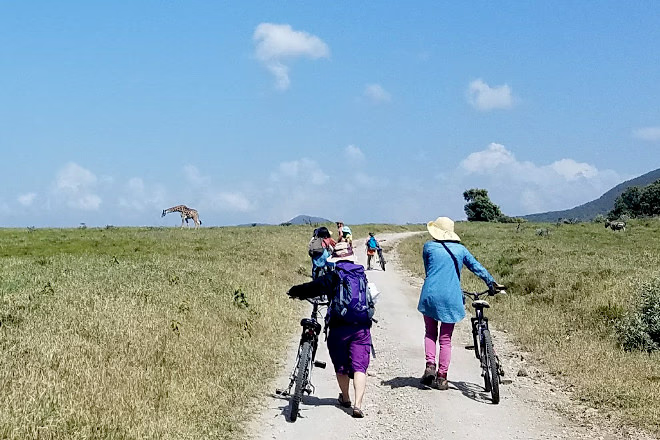
遠くにキリンが見える
保護区とされているエリアに野生に近い環境のシマウマやイボイノシシ、インパラなど動物がたくさん。広大なエリアが保護区として柵で囲まれているが、それでも本来の野生動物の生態系の移動範囲を再現するには足りないらしい。
持ち込んだ自転車で保護区として指定されたエリアを走ることができる。
この他にウォーキングサファリ、ボートサファリ、車でのサファリと4つのサファリツアーを体験した。

公園にあるナイバシャ湖から昇る朝日。
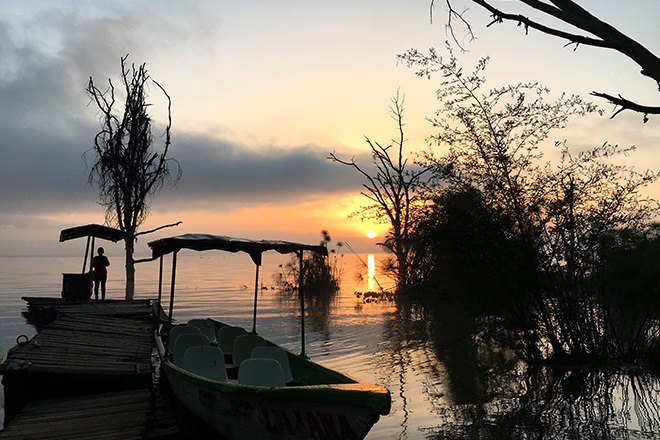
朝の湖では釣り人が湖に入り網漁をしていた。
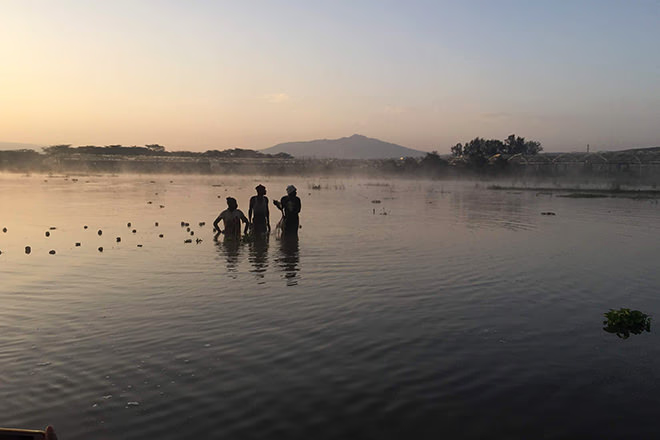
現地の釣り人が釣った魚。
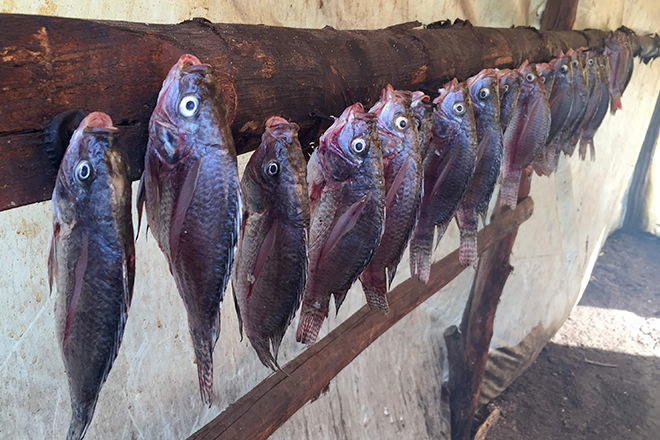
この魚を油で揚げて吊っておくと2、3週間保存して食べることができるそうだ。
乾燥しているケニアの気候では食料が腐敗しづらいよう。
交易の町、インド洋に面したマリンディへ
アフリカらしいサファリを満喫したあとは、内陸から離れ、てインド洋に面するマリンディへ。インド洋の貿易でで栄えた町だ。

海に面したマリンディの町。
内陸の地方に比べ暖かいこの地域ではアフリカの中でも果物が多く取れ、交易などで賑わってきた。ヨーロッパからバカンスで訪れる人が多かったため、外国人とみるとCiao!と声をかけてくる。

ケニアの海岸、インド洋から望む朝日。

マリンディの市場。
気候も暖かい海沿いの地域では標高の高いナイバシャより更にバナナやスイカなど果物が豊富だった。

インド洋の浜辺で朝から釣りをする12歳の少年。
釣った魚を売って生活費と教科書を買う資金にするという。
釣り人の仲間の中でも最年少だそう。
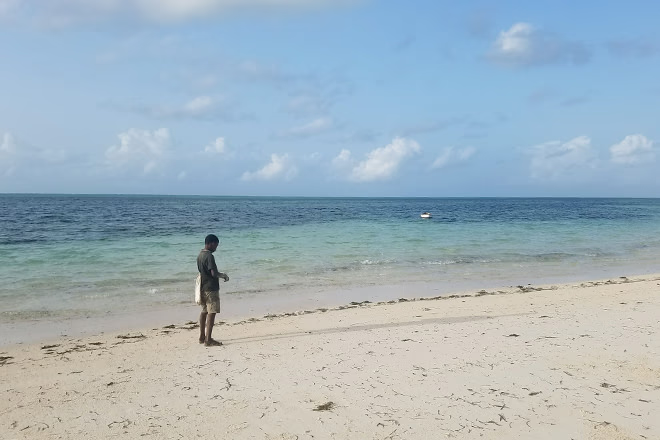
ダガムラ村の生活を体験
マリンディから奥地にある、ダガムラ村へ。歓迎で披露してくれたダンスを向かい合って一緒に踊る。肩を激しく前後に振るのが特徴。

周りには村の家以外、人工物は何もない。

木と土で作られた伝統的な作りの家。

粘土質の土は固まると石のように硬い。
いくつかの民族では成人を迎えると自分で家を建て、自立するそうだ。
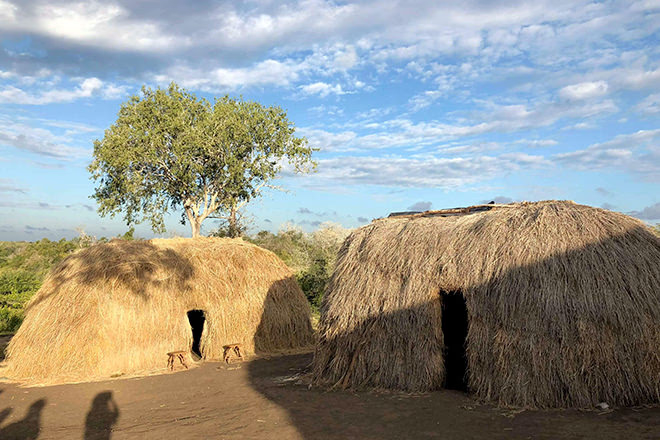
村に電気は引かれていない。
建物は木と草を乾燥させて作った紐で組み、土ないし藁で壁を張る。
どちらも村では伝統的な工法。
土は粘土質のため固まるとセメントのように固くなる。
この日、自分たちが寝るためのベッドを作った。
木で四角く組まれたベッドの枠に木の皮から作られた紐を編みこんでいく作業。
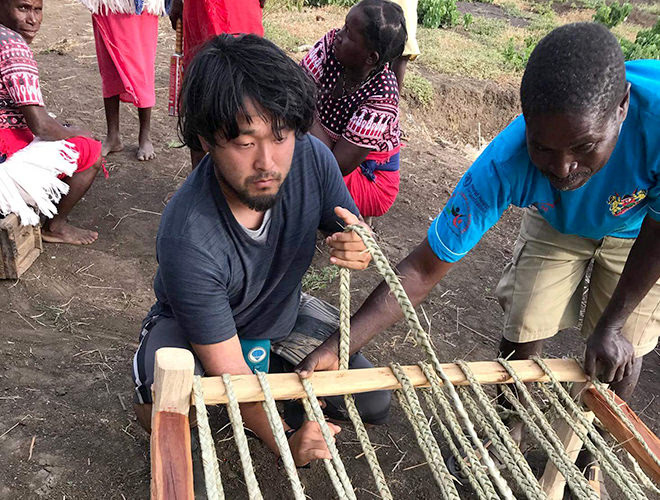
紐で張ったベッドはとても寝心地がよかった。

近くに水害で村を流された難民の人々が運ばれてキャンプをしている。
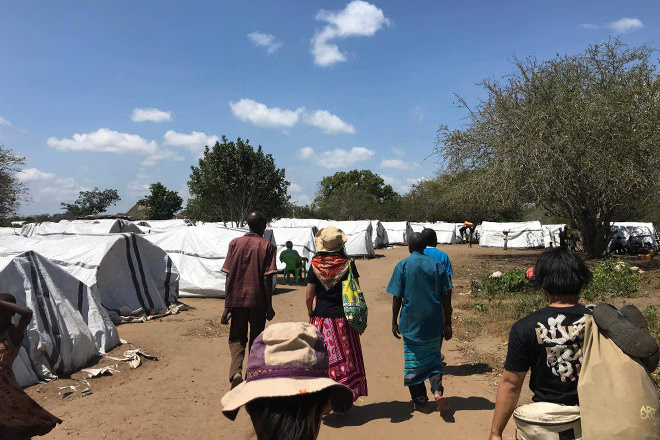
学校に集まった子供たちとも交流もした。
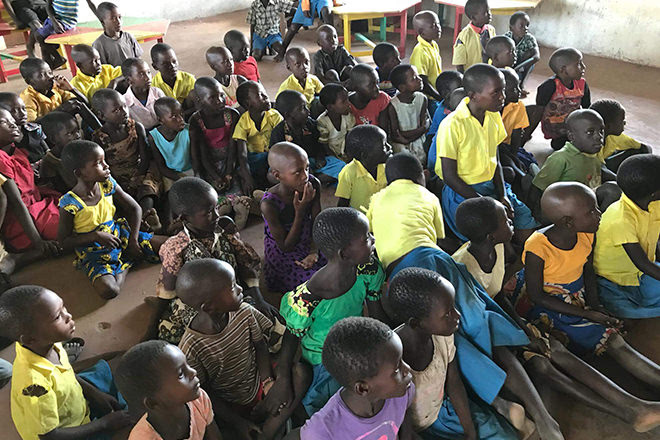
学校はもともと70人ほどだったが難民の子どもたちが160人弱入り倍以上に増えた。
そのことにより、教室の場所が足りず、下級生は青空教室で勉強している。

訪れた日は、ケニアの学校は夏休みの時期。
しかし学校には多くの子どもたちと先生の姿が。
外からお客さんが来るから歓迎しようと集まって特別に授業の様子を見せてくれた。
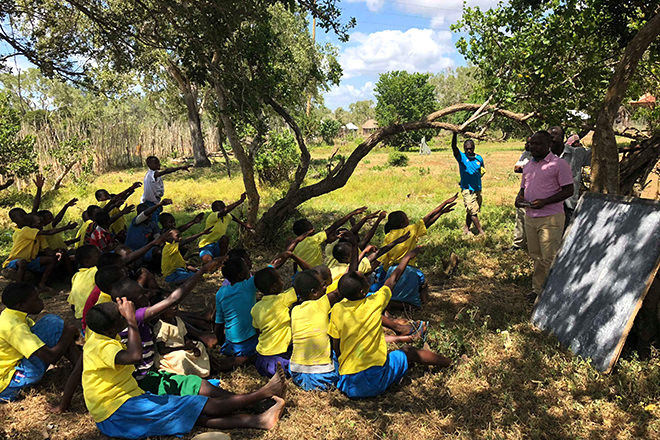
ケニアでは学校は行政が建ててくれない。
それぞれのコミュニティで施設を作り、行政の担当者が視察し、学校として機能できると判断されれば教員が派遣される。村では外貨を稼ぐ仕事が少なく、施設を造るお金を集めるのも大変だという。
旅の一番の目的、マゴソスクールへ
最後は、首都のナイロビに戻り、この旅のきっかけになったケニア最大のキベラスラムにあるマゴソスクールの子どもたちに会いにいく。
キベラスラムはナイロビの南西に位置するアフリカで最大規模のスラム。
居住者数はナイロビの人口の過半数を占めると言われている。
住民の多くはがれきや廃材を売って生計をたてている。
居住者が増え続けているため、最近では2階建ての建築が人気だという。
スラムは、地平線まで広がっているようにも見えるほど。どこまでもバラックがつづく。
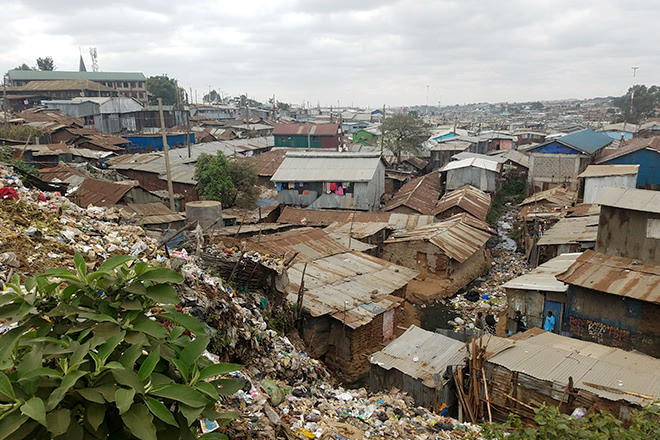
スラムの横には鉄道が走っている。

スラムは、形式の上では国の土地に勝手に住んでいるという扱いのため、都市開発のために強制撤去が行われることはよくあるそう。
大きく開けた通りは開発のための強制撤去の後という。

最終日にしてケニアで初めて見た本の販売。
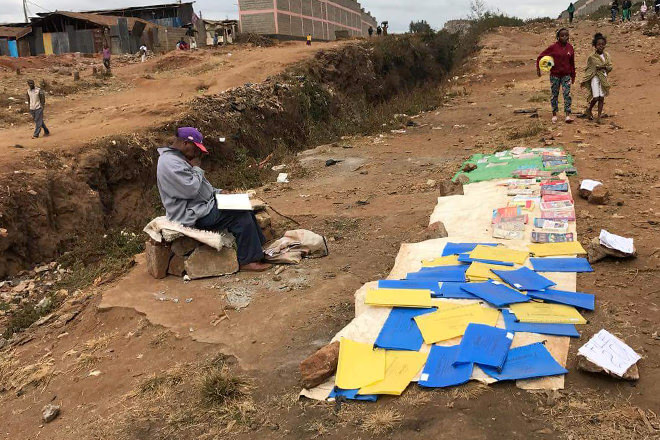
デパートなどに本屋はあるそうだが、物事を口伝や歌で伝える文化のため古い書物などはないようだ。
足元にゴミが散乱している様子はケニアの他の地域と一緒。

スラムのなかには排水が流れているためそこを中心に臭いがしている印象だった。

スラムでは警察官に依頼して護衛についてもらった。
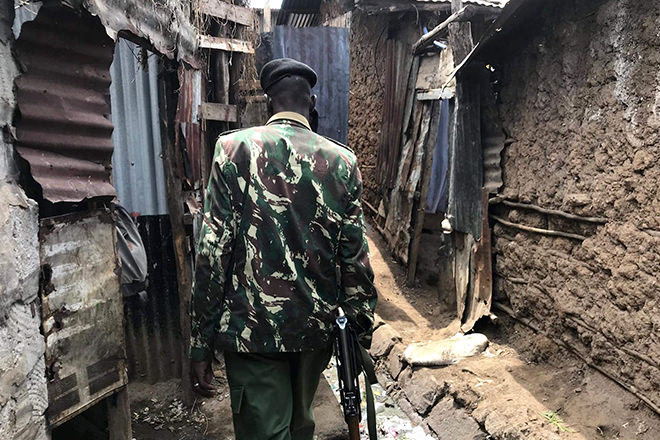
格好は物々しいが、明るく気さくに接してくれていた。
スラム出身の警察官もいるようで、知り合いに会っては挨拶を交わす姿もよく見られた。
ようやく、マゴソスクールに到着。
迷路のようなスラムの中塀で区切られた区画があり、塀の一角にある門をくぐると突然に開けたところがある、そんな印象の空間だった。
施設の案内の後、それまであちらこちらで遊んでいた子どもたちが集まって、歓迎の歌とダンスを披露してもらった。
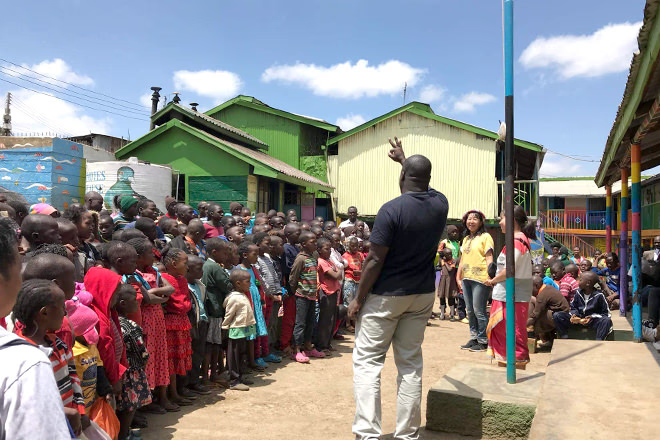
日本からの出し物として披露した相撲。

子どもたちが次々に名乗りをあげ、予定していた時間を押して盛り上がった。
マゴソスクールは、孤児、元ストリートチルドレン、労働させられていた子、虐待を受けた子どもたちの駆け込み寺となっている。子どもたちだけではなく、若者も大人も集まる。困った状況にある人たちが共に生きていく場所になっていて、家族のように生活をする人たち(マゴソファミリー)が常時約30人くらいいるという。

給食の様子。この日はウガリ(とうもろこしの粉を炊いたケニアでは一般的な主食)とスープ
このほか、幼稚園から小学8年生までの通いの生徒500名の授業やスラムの貧困者のための職業訓練所(洋裁と大工)と作業所を兼ねている。また、毎日の朝昼の給食の配布や高校生のための奨学金制度の運営もしている。

アフリカの伝統的な布、キコイやカンガを使った商品を制作する部屋
歓迎会とご飯のあとは、早川さんとツアー参加者、マゴソスクールの人たちと「よりよい未来をつくるために」というテーマでそれぞれの視点でディスカッションする時間を作ってもらった。
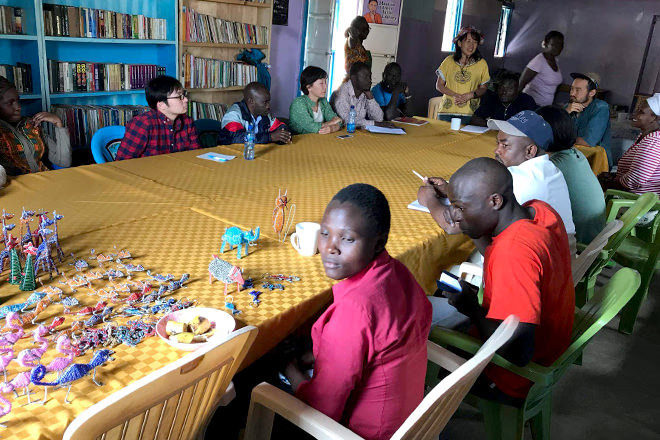
マゴソスクールからは、先生、洋裁士、図書司書、保育士、などのスタッフ、OB、OGの高校生が参加。彼らが直面している問題として話してくれたのは、教育のことや治安の悪さ、生活の不安定さ(食料など衛生環境や栄養不足による病気など)の3つから解放されることで子どもたちが十分な教育を受けることができるということ、そして目標を持つ、夢をかなえるチャンスがあることが大事ということだった。
彼らの発言内容を聞いて、日本はとても安定していると思えたためか、日本人メンバーからは意見が出づらかったように思えた。
学校の子どもたちは発言にとても積極的だった。グループで発表や出し物への参加を募った時など、控えめになる様子など見られなかった。
他のツアー参加者は、彼らのそんな姿を見て、子どもに限らず、日本人は積極性や活力がないと感じることが多いと発言していた。
ケニアの人たちは今日、明日を生きることが問題のため必死だけれど、そのなかで夢を持つことが難しい。
反対に日本は今日明日の生活が問題にならないほど安定していても、目標がわからないといったことが起こっている。
形は違えど、目標が持てていないところは共通していたのが印象に残った。
今回の旅を終えて
ケニアの人々の姿に惹かれて参加した旅。
実際に行って目にしてみて、どんな困難な最中にあっても、伝統を大事にし、自然と隣り合って生きる暮らしを感じることができました。
興味を持ったら是非イベントや記事の中で紹介していたページをチェックしてみてください。

